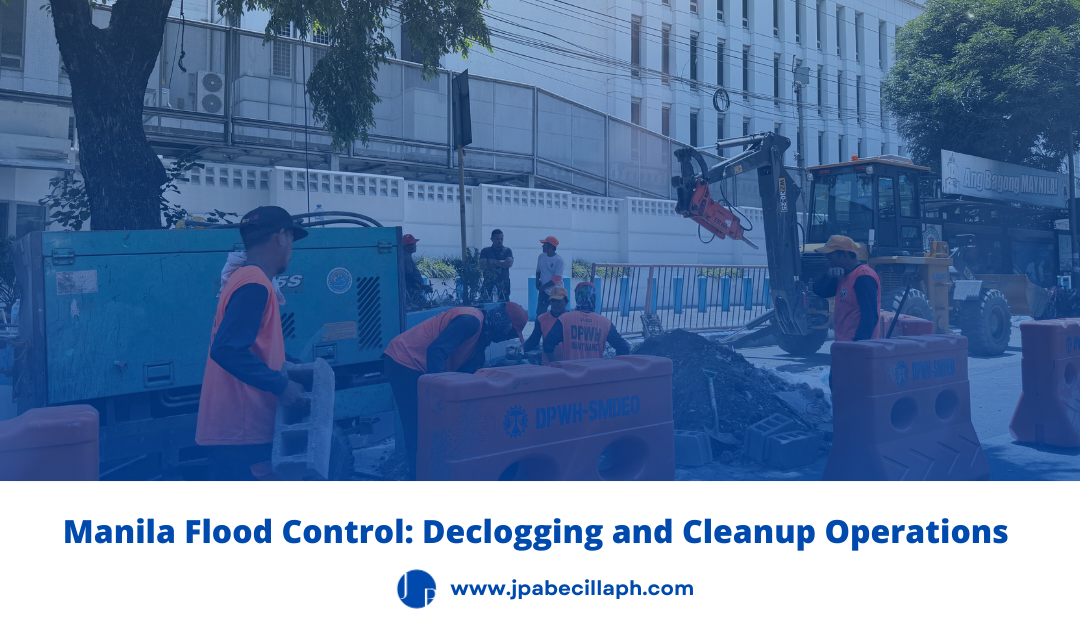This article serves as a follow-up to my previous piece, “Can We Stop Normalizing the Philippines as a DUGYOT Nation?”, where I questioned why we remain comfortable with the notion of the Philippines as a “dirty” nation. Fortunately, I’ve witnessed a concrete step that shows there’s still hope for change.
In Manila, Mayor Francisco “Isko” Moreno Domagoso is spearheading a massive canal cleanup and declogging effort as part of his Manila flood control strategy to combat flooding and maintain the city’s cleanliness. Let’s explore how these initiatives are sparking hope and demonstrating a commitment to a cleaner, safer Manila. This is an exemplary act that mayors across the country could follow.

The Manila Flood Control Operations
The cleanup and declogging operations, central to Mayor Isko’s Manila flood control efforts, are being carried out by the Department of Engineering and Public Works (DEPW) and the Department of Public Services (DPS), focusing on maintaining a clean drainage system across the city. Updates from Mayor Isko’s Facebook page and Manila Public Information Office (MPIO) have some of the following activities being undertaken:
- Estero de Kabulusan, Barangay 220, Tondo: The DPS Estero Rangers collected 36 sacks of estero waste as part of cleanup operations along Antipolo Street, contributing to Manila flood control by ensuring unobstructed water flow.
- Apostle San Pablo Church, Velasquez St., Brgy. 94, District 1, Tondo: Declogging of drainage systems was conducted to prevent blockages, a key component of Manila flood control.
- Fugoso St. to Oroquieta St., Brgy. 315, Zone 32, District 3, Sta. Cruz: Cleaning and declogging operations were performed to ensure water flow, supporting Manila flood control initiatives.
- Central Market, August 5, 2025: The Highway Division III of DEPW conducted a declogging operation as part of maintaining the drainage system, a critical step in Manila flood control.
These activities aim not only to prevent flooding but also to protect public health, especially during the rise of dengue and leptospirosis cases, as highlighted in a post: “We will not stop cleaning our esteros and drainage systems, especially now with the resurgence of dengue and leptospirosis.”
Mayor Isko’s Vision for Manila Flood Control
Mayor Isko Moreno has clearly expressed his dedication to addressing the flooding issue through robust Manila flood control measures, stating, “If you give the mayor the authority, there will be action and accountability. Let us handle it, because we face the people every day. And if we fail, there’s no one else to blame.” This call stems from his frustration with failed national agency projects, such as the Sunog Apog pumping station in Tondo, which he described as “brand new but not working, brand new but useless.”
In supporting President Bongbong Marcos’ stance against corruption in flood control projects, Mayor Isko said, “That’s just how it is—as they say, the pumping station built didn’t work. Someone must be accountable to the President. There must be someone responsible to the President.” These statements reflect his commitment to a cleaner and more effective Manila flood control system.
Related Post: Can We Stop Normalizing the Philippines As a DUGYOT Nation?
First-Hand Experience
Four weeks ago, after giving a courtesy call to Mayor Isko Moreno’s office together with Manila-based vloggers supportive of Isko Moreno, I personally witnessed a declogging operation at a canal in Manila, a key part of Manila flood control efforts. I saw firsthand how government workers conducted a major operation to remove garbage and debris clogging the water flow. Their dedication was inspiring, and I realized that their work goes beyond cleaning canals. It’s about giving Manila’s residents a renewed sense of hope. As I watched, it wasn’t just the canal being cleared; it was the lives of Manileños being given a fresh start through effective Manila flood control.
Community Impact
These Manila flood control operations aim to protect public health, especially amid the spread of dengue and leptospirosis, and provide immediate solutions for affected residents, such as the opening of 22 evacuation sites and the relocation of over 3,500 individuals on July 22, 2025. During my visit to Manila, I spoke with vloggers residing in the city who have been witnessing recurring floods. They have the same observation, “Before these Manila flood control operations, it flooded here every time it rained. Now, we can breathe easier knowing the government is doing everything to protect us.”
Mayor Isko’s Manila flood control initiatives are a significant step toward a cleaner and safer city. This is not just about clearing canals but about building a community filled with hope and dignity. With everyone’s support and participation, we can say, “Manila is no longer DUGYOT, but a city brimming with hope and transformation.” Through these Manila flood control efforts in every barangay, Mayor Isko proves that we should not be comfortable with the idea of the Philippines as a dirty nation. Instead, we must champion positive change for a more prosperous country.
Follow JP Abecilla – The Millennial Writer on Facebook, YouTube, Twitter, and Instagram for more updates!








1 Comment
Gillian
(September 11, 2025 - 2:34 pm)I think Mayor Isko’s cleanup drive really shows how much local leaders can achieve when they focus on action instead of excuses. Flooding in Manila has been a long-time problem, and these declogging efforts are a step in the right direction. As a student studying in Manila, I see and feel the impact of flooding directly, from disrupted classes to health risks whenever the streets overflow. But I also believe that no matter how many operations the city conducts, the results won’t last if people keep throwing trash into esteros and canals. Ordinary citizens need to be part of the solution by practicing discipline and supporting these programs. If government and community work together, Manila can truly move away from its “dugyot” image and become a cleaner, safer city for everyone.